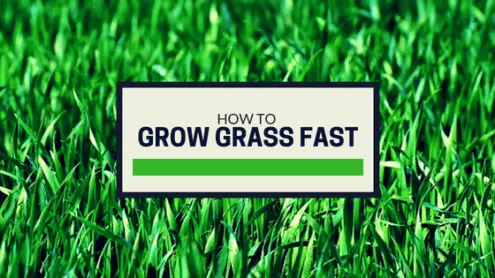Ideally, every grass seed would create a nice thick lawn in a matter of days. Unfortunately, grass grows slower than most of us would like. In some cases, it may take 30 days or more to just begin to germinate. The good news is that you can take steps to help promote a fast growing new lawn. It won’t grow over night, but you may speed up the process by following the below tips:
- Grass Seed: The type of grass seed you buy will have a big impact on how fast your grass grows. For example, Kentucky bluegrass typically takes 14 days or more to germinate. However, perennial ryegrass can germinate in as little as five days. View our article on seed germination to get an idea of the approximate germinate times of various grass seeds. Keep in mind that planting the fastest growing grass seed is not always the best for your lawn.
- Time of Year: The time of year when you plant your grass seed will have a big impact on its growth. The best time to plant cool-season grasses (grasses that thrive in the northern United States) is in early fall. Soil temperatures have become ideal by this time and weeds are typically minimal. Warm season grasses are best planted in late spring and summer since these grasses thrive during the warm season. Soil temperatures should be above 65°F.
- Starter Fertilizers: Starter fertilizer designed for new grass provides nutrients to seeds and helps speed up the growth process. Be aware that you should not use just any fertilizer on your new seed. Read the fertilizer label to be sure you are buying a fertilizer meant for new grass. Additionally, stay away from traditional weed and feed products or crabgrass preventers. These will deter your new seed from growing.
- Watering: One of the most important things to do when growing new grass is to provide your seed with ample water. You should water at least twice a day or more if it is hot or windy. Your seed needs to remain moist to successfully grow. However, you should not flood your seeded area. We recommend monitoring your seed area for the first few days of watering to make sure you are effectively watering.
- Soil: Your grass seed needs good seed to soil contact. The soil should be loose and not compacted. You should consider using lawn soil and core aerating your seeding area for the best results. Avoid foot traffic on the newly seeded area until the grass is ready to be mowed.
- Soil Test: A soil test will help you determine if your soil is acidic, alkaline, or neutral. If the soil test reveals a problem, you can then buy products to help improve your lawn soil to aid in grass growth. For example, lime is commonly used to help decrease soil acidity. You can pick up a soil test at your local hardware or on amazon. There are tests available that require you to ship a sample off to a lab and do-it-yourself soil kits or testers.
- Prevent Shade: If possible, you should trim the branches of your trees to allow more sunlight into a heavily shaded yard. Grass needs about 5-6 hours of sunlight, on average, to grow. Fescue is the best grass seed for shade and tends to grow relatively quickly. However, it needs about four hours of sunlight to stay alive.
- Mowing: You may be tempted to mow your newly sprouted lawn. However, you should wait until your grass grows to about 3.5 to 4 inches before cutting it. When you mow, be sure to mow high. Remove no more than 1/3 of the grass blade in a single grass mowing session. If you cut too soon, you run the risk of damaging your lawn and preventing growth.
- Consider Sod: You can purchase sod if you want an instant green lawn. Sod is typically sold in rolls and you will pay about $0.50 a square foot. Yes, this is quite expense and it must be installed properly, but it saves you from the headache of growing seed.
Table of Contents

